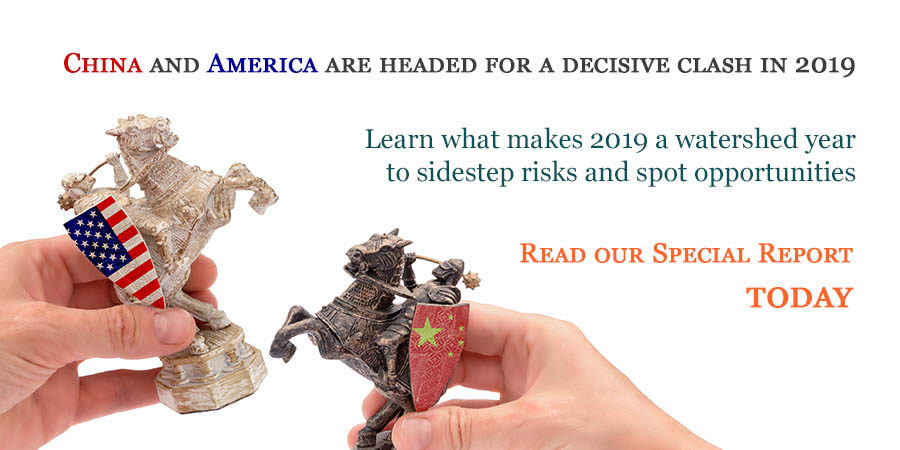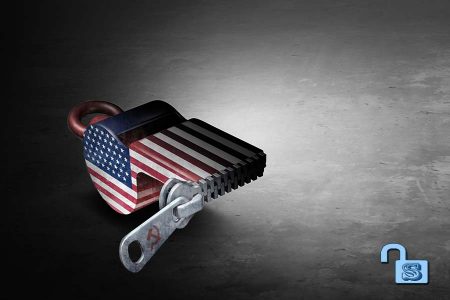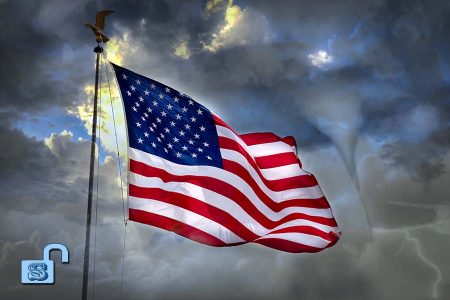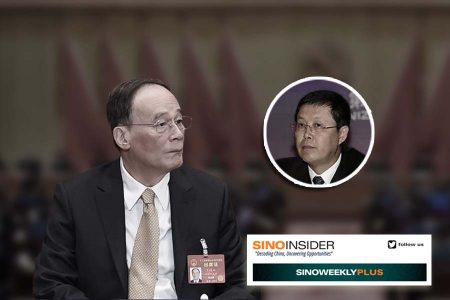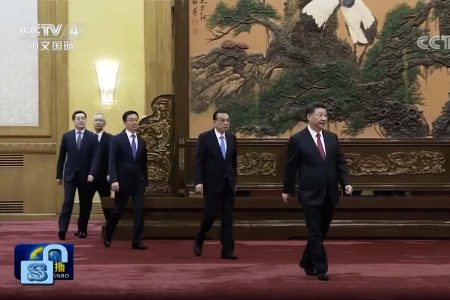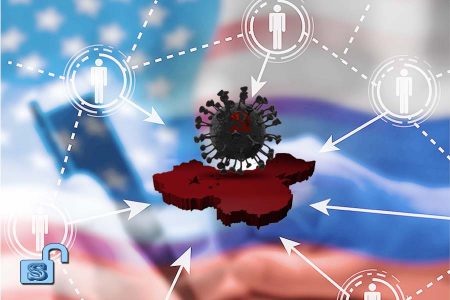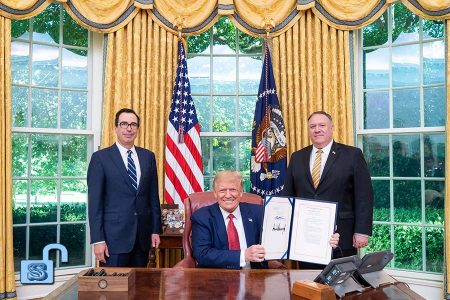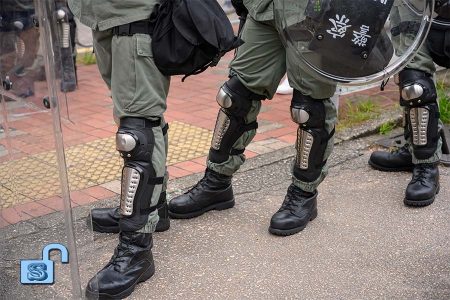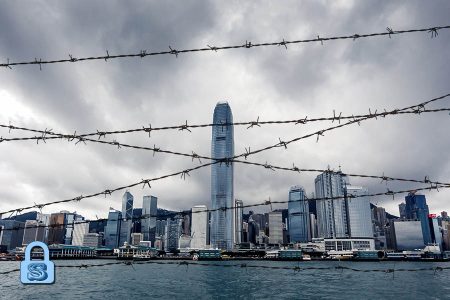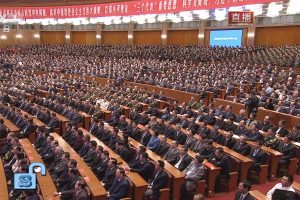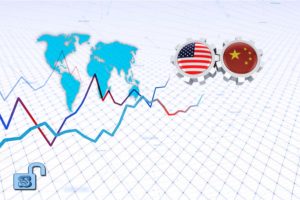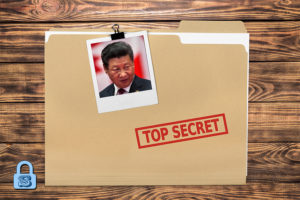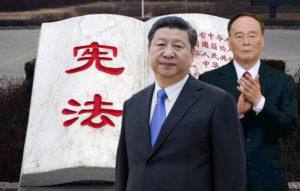◎ The CCP will likely try to drag out the trade negotiations, the implementation of the trade deal, and the enforcement mediation process to gain an advantage in the “new cold war.”
The Trump administration is looking to reach a trade agreement with China that will solve many long-standing issues between both countries, including intellectual property theft, forced technology transfers, and currency manipulation. “This is an epic deal, historic—if it happens,” said President Donald Trump in early April.
We believe that the Chinese Communist Party is exploiting Trump’s attachment to an “epic deal” to buy itself time to ensure regime survival and further its agenda of world domination. Unless the Trump administration takes action to counter the CCP’s delaying tactics, the United States is at risk of losing its advantage in the “new cold war” with the Chinese regime.
Delay, delay, delay
The CCP is notorious for pulling off delaying tactics when its survival is at stake. Delaying tactics buy the Party breathing space and allow it to stay in the game against overwhelming odds. As the Party “lives to fight another day,” it will simultaneously seize opportunities to dominate. For instance, the CCP traded space for time with its Long March to evade Chiang Kai-shek’s purge of communists. Later, the Party instigated the Xi’an Incident and forced Generalissimo Chiang to form a second United Front with them. During the Sino-Japanese War years, the CCP left most of the fighting to the Kuomintang troops while it built up its strength. And while the KMT and the CCP held peace negotiations after the surrender of the Japanese, the Red Army never stopped attacking the KMT forces even as Mao Zedong was publicly proclaiming, “Long live Chiang Kai-shek!” The CCP’s “survival-dominance” dynamic eventually led to the ousting of the KMT government and the founding of the People’s Republic of China.
In 2018, the Chinese regime faced another survival crisis after President Trump announced and implemented tariffs. China released weak economic data in the third and fourth quarter of 2018. The Shanghai index plunged over 24 percent in 2018 as compared to a year ago, while the Shenzhen index fell by over 30 percent. This January, top U.S. multinationals (Apple, Caterpillar, Nvidia, etc.) blamed weaker sales in China for lower earnings and revised down sales forecasts for 2019. Trade war pains likely led Xi Jinping to offer to make concessions to the U.S. in his dinner with President Trump in Argentina in December 2018. Due to Xi’s show of goodwill, both sides agreed to a 90-day trade war truce as Chinese and U.S. negotiators work on a trade deal. U.S. tariffs on $200 billion worth of Chinese goods, which were scheduled to be increased from 10 percent to 25 percent in December 2018, were postponed until March 1, 2019. However, Trump again postponed the tariffs in February 2019 due to “substantial progress in our trade talks with China.” By April, it had become evident that the CCP was resorting to delaying tactics.
While the Trump administration is hardline on China, the CCP seems to have identified a key weakness—the Trump administration will not go “all out” in pressuring China as long an “epic deal” remains within reach. To keep the “epic deal” just in sight without provoking tariffs, the CCP has offered to make important concession after concession one at a time. For example, Chinese trade negotiators committed to buying $1.2 trillion in U.S. goods in February, shifted position on forced technology transfer and other issues in March, and “acknowledged for the first time” to intellectual property theft and hacking in April. The CCP’s piecemeal rolling out of concessions has seen the trade war truce extended by over 60 days; the hike in U.S. tariff rate has now been delayed by over 150 days.
Advancing the agenda
The CCP appears to be exploiting the Trump administration’s attachment to getting a deal to buy itself time to regroup and delay further regime-threatening pressure from America while simultaneously advancing its global hegemonic agenda.
Meanwhile, the Trump administration has been relatively quiet on the Chinese regime’s recent geopolitical activities. We believe that it is possible that the Trump administration has been less vigorous in challenging the regime to avoid sabotaging the negotiation of an “epic deal” with China.
Below we look at four areas which the CCP has been working on during the extended trade war truce.
Belt and Road
1. The Belt and Road Initiative (BRI) has become even more important to the Chinese regime in light of the trade war. Through the BRI, the regime can export excess capital, push the internationalization of the renminbi, find markets for Chinese 5G equipment, and circumvent America’s geopolitical and trade pressures. In the long run, the successful implementation of the BRI will weaken U.S. presence in the Indo-Pacific and entrench the Chinese regime’s regional hegemony.
2. The CCP has found some BRI success recently. More countries have joined the BRI in 2019 (including Croatia, Italy, Peru, and Cyprus), while other countries (Austria, Switzerland, and Singapore ) have signed up for so-called “third-party cooperation.” In April, 37 foreign leaders attended the Second Belt and Road Forum, up from 29 at the first forum in 2017. Meanwhile, fourteen countries (including Austria, Portugal, Singapore, Thailand, Djibouti, and Egypt) became new signatories to the joint communique of the Second Belt and Road Forum.
3. There are two reasons why countries might find the BRI appealing despite U.S. warnings of the Chinese regime’s debt trap diplomacy and hegemonic ambitions.
First, while the U.S. economy continues to perform well (3.2 percent growth in Q1 2019), the global economy is seeing a “synchronized slowdown,” according to an April 2019 update to a tracking index compiled by the Financial Times and the Brookings Institution. The need to reverse flagging GDP growth may sway countries with prior reservations (such as America’s European allies) about China to take up membership in the BRI.
Second, countries might be more amenable to giving the BRI a second chance after its recent “reboot.” Regime propaganda about the BRI was toned down noticeably in the lead up to the Second Belt and Road Forum. At the forum, Xi Jinping made commitments to address the many complaints about the BRI (debt trap, corruption, not environmentally friendly, etc.) while promoting its “mutual benefits” and achievements. Xi also promised that the BRI will adhere to international laws and standards. The BRI “reboot” appears to have convinced at least one major critic. Malaysian leader Mahathir Mohamad, who previously threatened to scrap BRI projects and warned of “new colonialism,” said at the Second Belt and Road Forum that he is “fully in support” of the initiative and that Malaysia “will benefit from the project.”
4. The U.S. did not send high-level officials to attend the Second Belt and Road Forum. A U.S. State Department spokesperson told Reuters that America will “continue to raise concerns” about the BRI’s “opaque financing practices, poor governance and disregard for internationally accepted norms and standards.”
America, however, has been relatively muted in challenging the BRI during the period of trade negotiations.
Splitting alliances
1. The Chinese regime has established closer ties and made further inroads into European countries recently.
In March, Italy joined the BRI after Xi’s trip to Europe. China also signed several business contracts worth billions of euros with France.
In April, Croatia joined the BRI and was invited to issue renminbi-denominated “Panda bonds.” Meanwhile, Li Keqiang signed a China-EU joint statement that touched on trade, diplomacy, and other issues. On April 23, Britain’s National Security Council decided at a meeting attended by U.K. Prime Minister Theresa May to allow Huawei to construct noncore parts of the country’s 5G networks.
(See here and here for our full analysis on the CCP’s moves in Europe.)
2. There are several reasons why the CCP might want to draw closer to Europe.
First, the Sino-U.S. trade war has made it more costly to export products to America, and the U.S. has essentially prevented Huawei and other Chinese telecommunications makers from expanding in the U.S. market. The Chinese regime thus needs to find alternative markets to export its 5G and other goods, and mitigate the impact of the trade war.
Second, having more European countries in the BRI helps the internationalization of the RMB and advances the CCP’s hegemonic agenda.
Third, the CCP is almost certainly looking to draw a wedge between America and its European allies for its benefit. A split in the alliance will weaken U.S.-led global efforts to “contain” and counter the threat of CCP expansionism and influence operations.
3. The U.S. has warned its allies in Europe and elsewhere about the threat of using Chinese 5G gear, and has threatened to curb intelligence-sharing if warnings go unheeded. On April 29, deputy assistant secretary of state for cyber policy Robert Strayer told reporters in Brussels that Washington would “have to reassess the ability for us to share information” with European allies and be “interconnected with them in the ways we are today” if they choose to use Chinese telecommunications equipment for 5G networks.
Hong Kong
1. Hong Kong is looking to make changes to its extradition law before July to allow the Hong Kong government to extradite wanted persons to Taiwan, Macau, or mainland China. The extradition law inspired mass protests in Hong Kong recently, with tens of thousands taking to the streets. Protest organizers estimated that 130,000 people participated in a rally on April 28, while the police estimated about 22,800.
Critics of the extradition law argue that people from countries not covered by Hong Kong’s current extradition treaties (such as the U.S. and the U.K.) are at risk of being arrested and extradited to China for political reasons despite safeguards. Critics also believe that the extradition law is more draconian than Article 23 of the Basic Law, the national security legislation which the Hong Kong government once tried but failed to enact.
Businessmen and persecuted groups are particularly concerned that the Chinese regime will abuse an amended extradition law in Hong Kong to serve its own agenda. In Hong Kong social media forums, Chinese regime-backed “50 cent army” commentators brag that the extradition law will be used to target run-away Chinese officials, Falun Gong adherents, and anti-CCP groups, but not businessmen.
The American Chamber of Commerce in Hong Kong said in a statement that it “continues to have serious concerns” about the proposed amendments to the extradition law. On April 5, U.S. Senator Marco Rubio and Rep. Jim McGovern said in a statement that the proposed law “will erode Hong Kong’s reputation as a center of commerce governed by the rule of law.” The statement added that “the people of Hong Kong and foreigners residing in Hong Kong—including 85,000 Americans—must be protected from a criminal justice system in mainland China that is regularly employed as a tool of repression.”
At the time of writing, the Trump administration has not commented on the Hong Kong extradition law.
2. The Chinese regime will have increased control over Hong Kong, a semi-autonomous Chinese city with its own mini-constitution, should the Hong Kong government pass the proposed extradition law. The CCP will also likely attempt to influence pro-Beijing Hong Kong lawmakers to use similar legislative tactics to pass Article 23.
Hong Kong’s democracy and autonomy are at risk of being fully eroded before the “one country, two systems” arrangement expires in 2047. The CCP’s tactics in Hong Kong serve as a warning to Taiwan; the regime originally designed the “one country, two systems” model for the reunification of the PRC and the ROC, and has not given up trying to persuade Taiwan to adopt the model.
3. The Chinese regime has been taking advantage of Hong Kong’s status as a separate customs zone from the mainland to lessen the impact of U.S. tariffs. For instance, the Hong Kong Trade Development Council noted in January that the use of an obscure “first-sale rule” had “increased dramatically” in the past several months. Under the “first-sale rule,” Chinese companies that sell products to Hong Kong trading companies before the products are then sold to the U.S. pay a lower tariff rate.
Taiwan
1. The CCP has used the trade negotiation period to step up pressure on Taiwan. Based on our observation, there are three developments in cross-strait relations that could affect America’s national and geopolitical interests.
First, the CCP has been threatening to reunify Taiwan by military force since the start of the year. The People’s Liberation Army has also stepped up military activity in the Taiwan Strait.
Second, the CCP is making an issue out of America’s increased support for Taiwan. In March, the Chinese regime’s defense ministry warned that it would be “very dangerous” for Washington to continue backing the ROC, and said that it was opposed to the U.S. selling arms to Taiwan. Some Taiwanese officials, politicians, and potential candidates for the 2020 Taiwan presidential election have also blamed the Tsai Ing-wen government for straining cross-strait relations by antagonizing the PRC with arms purchases and drawing the ROC closer to the United States.
Third, there are increased concerns about the CCP’s efforts to interfere in the 2020 presidential election. Aside from influence campaigns, a recent worry in Taiwan is the possible election of a “compromised” candidate that will ultimately serve as Beijing’s proxy. In the worst-case scenario, a compromised Taiwan president could approve a ROC-PRC reunification solution without Beijing needing to fire a single shot.
2. Unlike the previous three areas, the Trump administration has been quite strong in supporting Taiwan during the period of trade negotiations.
Since the start of the year, U.S. warships and Coast Guard vessels have been sailing through the Taiwan Strait with increased regularity. The two most recent sail-throughs were also made just before top U.S. officials (U.S. Treasury Secretary Steven Mnuchin and U.S. Trade Representative Robert Lighthizer) were due in Beijing for trade negotiations.
Members of Trump’s Cabinet have also been public about backing Taiwan. In March, White House economics and trade advisor Peter Navarro wrote in a New York Times op-ed that Taiwan may soon buy 108 M-1 tanks. And in a congressional hearing in March, U.S. Secretary of State Mike Pompeo said that America plans to take more action in line with the Taiwan Travel Act. Last October, U.S. Vice President Mike Pence said in a speech at the Hudson Institute that “America will always believe Taiwan’s embrace of democracy shows a better path for all the Chinese people.”
3. The stakes are high for the U.S. if the CCP manages to take over Taiwan.
First, the South China Sea would effectively become China’s territorial waters once Taiwan goes over. The Chinese regime would also likely use the island as a base for its expansion in the region. America will find it harder to carry out freedom-of-navigation operations in the Indo-Pacific.
Second, a ROC-PRC reunification would crucially weaken America’s influence in the region. Countries in Southeast Asia that are friendly with the U.S. could also shift their allegiance to China instead of maintaining a balancing act between the two powers. In the long run, the Chinese regime would find it much easier to establish regional hegemony once Taiwan returns to the mainland.
Third, America would lose a critical ally and a beacon of democracy in Taiwan should the CCP succeed in a takeover. Other democracies and overseas Chinese would likely become disillusioned with the U.S. and become more susceptible to CCP influence operations. America’s national and geopolitical interests could become severely compromised, and the “Taiwan card” will no longer be in play to restrict the CCP from making bolder plays in the region.
Finally, the U.S. would be responsible for a worsening of the human rights situation in the region if it does not curb the CCP’s efforts to swallow Taiwan by force or otherwise. The CCP has always resented Taiwan’s transition to democracy because a democratic and successful Taiwan runs counter to its propaganda about how the “low quality” Chinese people are “ill-suited” for democracy. Per CCP characteristics, the Chinese regime will find ways to severely persecute the Taiwanese people for “standing up” to the communist dictatorship after ROC-PRC reunification. And America will find it very difficult to intervene in a human rights crisis in a reunification scenario because the CCP can accuse the U.S. of “interfering in domestic politics.”
What’s next
The CCP will likely strive to drag on the trade negotiations for as long as possible without being penalized by President Trump. Once it is no longer possible to delay the negotiation phase, the CCP will likely make whatever concessions it needs to make at the midnight hour to seal the trade deal.
If the Trump administration spots the CCP trap, it may try to get the trade deal finalized in May and signed in May or early June. If the Trump administration fails to spot the trap, then the CCP would try to delay the signing of a deal beyond June, or at least until after the passing of the Hong Kong extradition law.
Getting the trade deal, however, does not mean that the U.S. has escaped that CCP’s delaying tactics. The CCP will likely delay the full implementation of the trade agreement, and then find ways to delay again during the mediation phase when the U.S. enforcement mechanism kicks in. Ultimately, the CCP will do its best to give Trump an “empty” victory in the trade war while exploiting delays to put itself beyond defeat and advance its domination agenda.
Get smart
We predicted the CCP’s delay tactics and other possible maneuvers in our special report, “2019: A Waterloo Year for China and the United States.” Businesses, investors, and governments must account for risks in Sino-U.S. relations to avoid making costly missteps.

